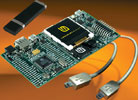
Luminary Micro has announced the immediate availability of 28 new Stellaris family members, including what is said to be the first integration of universal serial bus (USB) on-the-go (OTG) and host capability in the ARM Cortex-M3 architecture.
Additionally, the announcement strengthens the position of Stellaris microcontrollers in precise and safeguarded motor control applications with augmented IP for superior motion control capability.
Each of the 28 new microcontroller ships with the Stellaris Peripheral Driver Library and Bootloader conveniently pre-programmed in read-only memory, and each new device integrates the ARM PrimeCell 32-channel configurable μDMA controller, designed and specifically optimised by ARM for use with the Cortex-M3 processor and providing features normally only available in high-end application processors, such as advanced scatter/gather transfer modes.
Included in the new release are six members of the LM3S3000 USB series and 14 members of the LM3S5000 CAN+USB series. The announcement also adds 5 new 64-pin package members to the LM3S1000 realtime MCU series and 3 new 64-pin package members to the LM3S2000 CAN series. Together with large on-chip memories, enhanced power management, and expansive I/O and control capabilities, the new Stellaris family members are optimised for industrial applications requiring reliable connectivity, including motor and motion control, factory automation, test and measurement instrumentation, HVAC and building control, gaming equipment, medical devices, consumer appliances, and fire and security systems.

New industrial connectivity options with USB
With increased interest in industrial market segments, USB improves industrial connectivity by providing the advantages of hot swapping capability and power over a fast and standardised serial interface. With its USB Host and OTG support, the new Stellaris MCUs enable new applications of USB technology such as use of Flash memory sticks for device configuration and storage logging information.
The LM3S3000 series and LM3S5000 series feature a USB controller that can be configured for USB Host mode or USB Device mode in compliance with the USB 2.0 specification for full speed operation. Several of the microcontrollers also allow the USB controller to be configured in the new USB On-the-Go mode, allowing for usage in Host-mode or in Device-mode depending on the desired configuration in a given system state.
New motion control capabilities
Stellaris microcontrollers have long featured a pulse width modulation (PWM) module designed for meticulous motion control, with capabilities typically found only on costly specialty devices. Today's announcement extends this capability with up to eight full motion control PWM channels (four pairs) and up to four fault-condition handling inputs to quickly provide low-latency shutdown and prevent damage to the motor being controlled. The enhanced PWM module also features a dead-band generator providing shoot-through protection, synchronisation of timers enabling precise alignment of all edges, and an optional hardware quadrature encoder enabling precise positioning sensing.
Peripheral driver library in on-chip ROM
Each of the new Stellaris devices ships with the Peripheral Driver Library conveniently pre-programmed in read-only memory (ROM). This library is a royalty-free software library for controlling on-chip peripherals, and includes a bootloader capability. The library performs both peripheral initialisation and peripheral control functions, with a choice of polled or interrupt-driven peripheral support, and takes full advantage of the advanced interrupt performance of the Cortex-M3 core. No special pragmas or custom assembly code prologue/epilogue functions are required.
For applications desiring in-field programmability, the bootloader can act as an application loader and support in-field firmware updates through the UART, I²C, SSI or USB interfaces.
Low power capabilities
Many of the new MCUs feature a battery-backed hibernation module that includes a realtime clock, 256 Bytes of non-volatile battery-backed memory, and the ability to wake on a realtime clock match, external pin interrupt or low battery event. Even using the realtime clock in hibernate mode, a standard CR2032 watch battery can support a Stellaris microcontroller in hibernate mode for over three years.
New evaluation kits
This announcement includes the immediate availability of two complete evaluation kits: the LM3S3748 USB Host+Device Evaluation Kit and the LM3S3768 USB On-the-Go Evaluation Kit. Each kit includes evaluation boards, all required cables, a choice of evaluation tools suites for popular development tools, documentation, the Stellaris Graphics Library, applications notes, and everything a developer needs to get up and running in 10 minutes or less. Both kits span the design spectrum from evaluation to prototyping to application-specific design by functioning both as an evaluation platform and as a serial in-circuit debug interface for any Stellaris microcontroller-based target board.
| Tel: | +27 11 608 0144 |
| Email: | [email protected] |
| www: | www.nuvisionelec.com |
| Articles: | More information and articles about NuVision Electronics |

© Technews Publishing (Pty) Ltd | All Rights Reserved